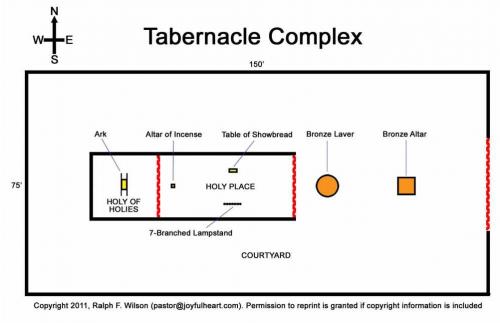The Tabernacle PT3

The tabernacle had an outer court that was 150 feet long by 75 feet wide. It was very small compared to the rest of the camp, just like the Church is very small, when compared to the rest of the world.
At the far end of the outer court was a tent- 45 feet long and 15 feet wide. this was divided into two parts-the holy place (30 feet by 15 feet) and the most holy place (a 15-foot square.) the height of the tent was 15 feet. This made the most holy place into a cube, having the same length, breadth and height.
In Revelation 21:16, we read that the heavenly Jerusalem (the bride of Christ is also a cube- 1500 miles long, wide and high. This symbolizes that those whose depth (inner life) is not equal to their external life-the front that they project to others-cannot live in God's presence.
God rejects hypocrites who give an appearance of spirituality to others, but who have no corresponding inner life (depth).
The tabernacle was surrounded by the camp of Israel on all four sides, There was a specific place for each tribe. The three sons of Levi- Merari, Gershon and Kohath- looked after the tabernacle and their tents were closest to the Tabernacle. When the tribe of Levi was taken out of the reckoning of Israel's tribe's, the tribe of Joseph was split into two tribes- Manasseh and Ephraim. So there were still 12 tribes.
The outer court of the tabernacle is described in 27:9-19. The material that formed this barrier was fine white linen symbolizing righteousness. The symbolism is revealed in the Book of Revelation where, at the wedding of Christ with His bride (the church) who has made herself ready for the wedding. Her wedding dress will be made of fine linen:
Revelation 19:8 And it is granted to her that she should clothe herself with fine linen, glittering and white. For the fine linen righteousness/justification of saints.
The wall of fine linen around the tabernacle presented a barrier to those who were not 'righteous before God' making sure that they would not have access to the courtyard. This teaches us that the thing that separates those inside the Church from those outside, is not a higher level of human righteousness, but that those inside are clothed with the righteousness of Christ.
When speaking of being "clothed with the righteousness of Christ, the Church teaches that the scriptures say that we are justified by the remission of our sins,and also sanctified and renewed in the inner man.
The white linen also symbolizes the simplicity that should characterize the Church. Babylon the harlot, on the other hand, is depicted in Revelation as grandly decked- in contrast to the simplicity found in the bride of Christ. (compare Revelation 17:4 with 19:8).
There was only one entrance to the tabernacle- a 30 foot wide curtain on the east side, by which alone anyone could enter. This symbolized Christ being the one and only way to the Father. One entered the tabernacle with his back to the sun (in the east), indicating thereby his rejection of the worship of the sun (that was common in Egypt, and all over the world at that time.) Unfortunately, there are Christians who still face east today, when they pray-especially at their "sunrise services" on Easter morning! The devil has cleverly brought them full circle back. With out realizing what they are doing, they are imitating those who at one time worshiped the sin-god of the Egyptians!
Does it make you a "pagan" if you are involved in a sunrise service? I will not tell you what you should or should not do. I will say this however, if you feel convicted not to participate in such a practice and then do, it is sin for you to do so.
(Romans 14:22-23) "Hast thou faith? Have it to thyself before God. Blessed is he that condemneth not himself in that which he alloweth. But he that discerneth, if he eat, is condemned; because not of faith. For all that is not of faith is sin."
Now concerning the outer court, there were two items- the altar of sacrifice and the laver.
The tent had a curtain at the entrance to the holy place. between the holy place and the most ly place. Between the holy place and the most holy place was a thick curtain ("veil" Hebrews 10:20). This was the veil (duplicated in the temple in Jerusalem), that was rent in two, when Jesus died on the cross, indicating that the way to fellowship with the Father was now open to all.
All Israelites were permitted to enter the outer court. But only the priests could enter into the holy place. The holy place contained the altar of incense, the lampstand and the table of bread.
Into the most holy place, only the high priest could enter- and that too, only once a year, on the day of atonement, with the blood of the sacrifice. There the ark of the covenant was kept, covered by the mercy seat. The glory of God was visibly present here.







 Follow
Follow

